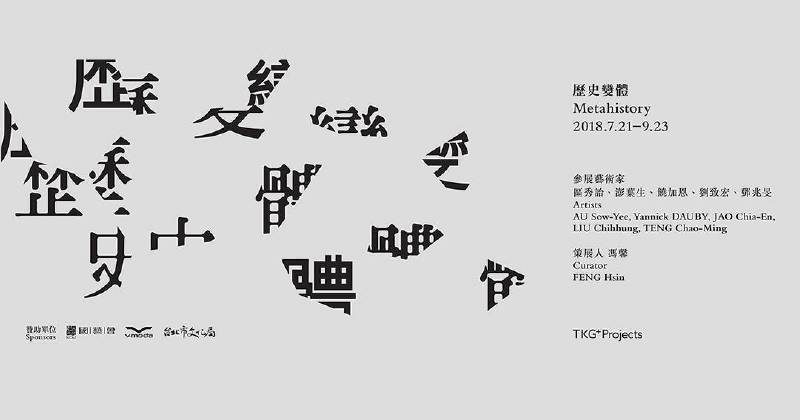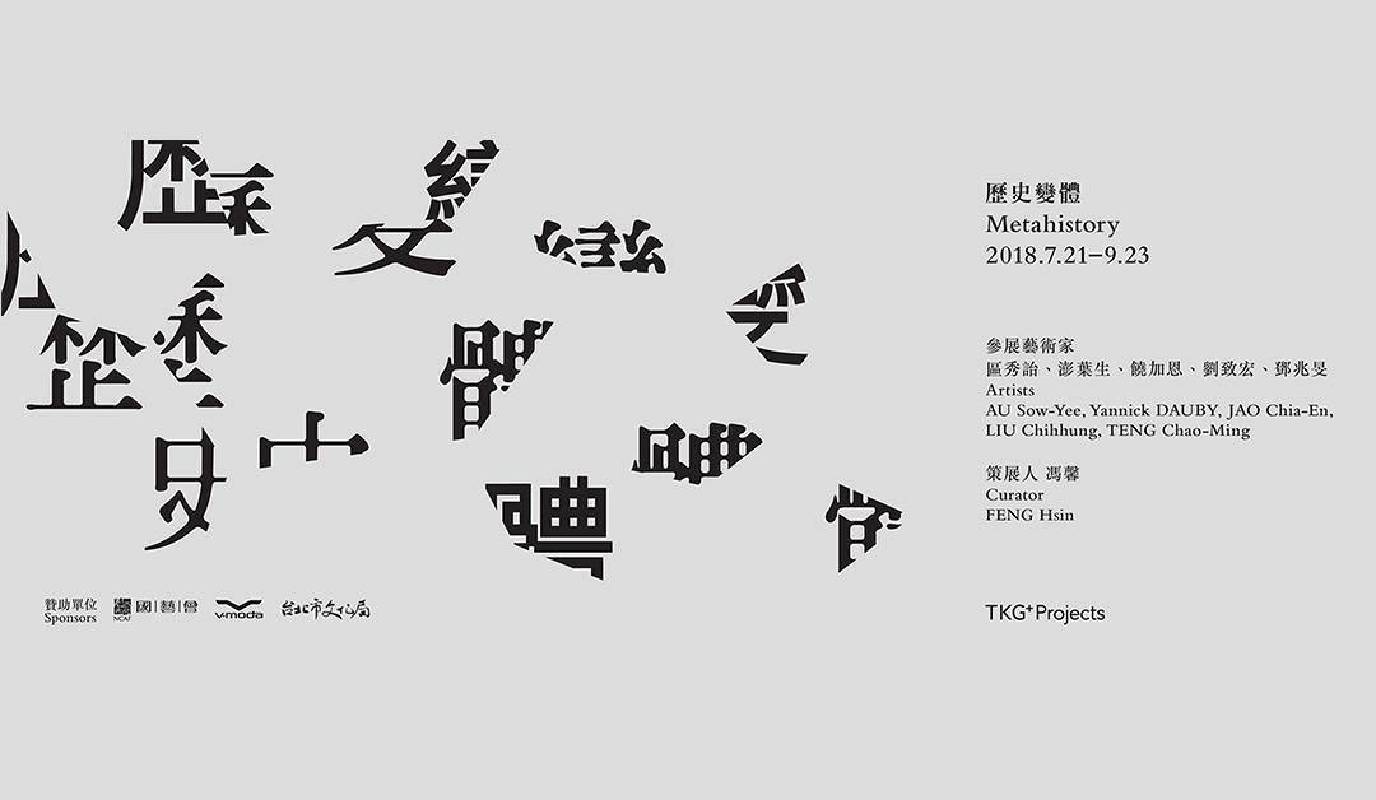TKG+
【歷史變體 Metahistory】

-
展期
日期:2018-07-21 ~ 2018-09-23
-
地點
114 台北市 內湖區瑞光路548巷15號B1
-
參展藝術家
區秀詒 AU Sow-Yee、澎葉生 Yannick DAUBY、饒加恩 JAO Chia-En、劉致宏 LIU Chihhung、鄧兆旻 TENG Chao-Ming
-
如果說對於父執輩影響最劇烈的社會狀態是戒嚴,那對於解嚴後出生的我們這一代,是什麼?
展覽挪用社會語言學中的「語音變體」,通常指稱單一語言在不同區域中衍生發展的地域方言,「歷史變體」透過由語言文字構成的歷史敘事為思考基點,以此狀態比擬解嚴之後,教科書版本開放,歷史論述不再是單一的官方論調,歷史的起點開始出現分歧,課本編撰產生之歷史書寫差異性所造成動盪與不斷變化的狀態。在這樣的狀態下,我們如何形塑對於自體的文化認同?而經歷過戒嚴時期的一代在解嚴後,面對過往諸多認知的翻轉,如何在落差中重建認知?在此我們必須先釐清歷史的生成必然是伴隨著書寫者的主觀與其背後的意識形態,執筆者如何篩選、呈現史料,在這段選擇的過程便是意識的運作,掌握歷史論述話語權的人,也同時掌握了權力意識的形式、傳播。
當歷史生成與書寫的權力開放,歷史將不再依附國家認同;而國家認同的崩解過程,則使得我們面對歷史需重新檢視過往累積的史料檔案,並開始能閱讀到背後的意識形態,將其成為個人可以再重新認知、編織的歷史觀點。那麼這樣的編織過程,不論是藉由史實對過往論述翻案,又或是將這樣的敘述拆解後再述,我們將發現其不脫離一個核心:我們如何想像自身。本展邀請三位台灣藝術家饒加恩、鄧兆旻、劉致宏,以及兩位長駐台灣的馬來西亞藝術家區秀詒與法國藝術家澎葉生,以歷史架構的生成出發,試著將歷史生成的過程與結構拆解,並以這些作品試圖彼此應對、交織對話。
歷史的書寫,在用字上往往可以反映主筆著的意識,面對歷史的閱讀,我們能否能時時保持自覺去挖掘主筆者書寫背後的意識形態?展覽中透過鄧兆旻作品《一個紀念碑,紀念釐清的(不)可能性》(2012),討論敘事如何拆解,以及重新梳理進行拆解的脈絡與自我對話的過程,並拋擲出關於紀念碑未來走向的提問。而在「大敘事」崩解的狀態下,澎葉生與劉致宏則是分別透過作品《台北2030》與《聲音地誌─高雄、恆春、台南臨海、北投》,逐步開創與挖掘在地「小敘事」的存在,試圖創造理解的不同視角,包含了不同感官閱讀的可能性,這些採集/編集的紀錄既反映的每一個在地的當下,也同時擴張我們對於每一個地區的想像。饒加恩的作品近期深入探討殖民歷史及亞太平洋地區的跨文化議題,饒加恩的新作延續2017年作品《逆時針》所討論的高士部落,以對於發展在地觀光的經貿文化研究分析,透過今昔交織的歷史事件與當地建物,探問背後脈絡的意識形態與認同想像。長居於台北的馬來西亞藝術家區秀詒的作品《棉佳蘭一日無光(第一章)》則是創造了一個虛構的理想地─「棉佳蘭」(Mengkerang),由故事接龍的參與者共同建構了一個想像中的烏托邦。展覽期間特邀藝術家陳飛豪舉辦一場座談兼作品特映,以神社為連結日本時期與現今場域的台北城想像,透過陳飛豪的四個創作計劃所對應到的四處台北城內具體的地點,呈現日本時期台灣與今日台灣從地景到社會變遷上的演變。
如果能意識到歷史結構性的問題,挖掘與翻轉過去仍待解的檔案,或許便能奪回書寫。在來回組織、閱讀與自審的過程,也反映我們是如何思考自身,以重新書寫將我們的認同形塑為文化,回應當下的現實,並將現實導向未來。面對歷史不單是一個當下的問題,就如同英國作家歐威爾於《一九八四》中提道「誰控制過去就控制未來,誰控制現在就控制過去」。
------------------------------
If the greatest impact to the social state is considered to be martial law, then what is it for our generation, born after martial law was lifted?
The exhibition applies the concept of "language variant" as defined in linguistics usually to refer to regional dialects of a single language that derive and develop in different localities to "historical variant” of historical narratives composed of words and phrases as a contemplative basis, and using this as an analogy for the unrestricted publication of textbooks post-martial law, where historical narrative was no longer a single official version. Points of genesis begin to diverge, and a continually state of change and turbulence results from the variations in written history produced by the editorialization of textbooks. In these conditions, how do we shape our subjective cultural identities? How does the generation who lived through martial law reconstruct as they confront the numerous cognitive upheavals of the past after the lifting of martial law? Here, we must first clarify that the production of history necessarily accompanies the writer's subjectivity and underlying ideologies. The process of selection as a writer culls and presents historical materials is precisely consciousness at work. Those who hold the right to historical discourse simultaneously have a grasp on the format and dissemination of power-consciousness.
As the right to generate and write history is opened up, history is no longer dependent on national identity; the process of the collapse of national identity compels us to confront history and necessitates an inspection of the accumulated historical materials and archives of the past, and to begin to read the underlying ideologies so it becomes a historical perspective that individuals can weave and learn anew. We have found that this process of weaving, whether in overturning past narratives through historical realities, or dismantling then re-telling these narratives, does not stray from the central core of "How we imagine the self." For this exhibition, three Taiwanese artists JAO Chia-En, LIU Chihhung, TENG Chao-Ming; and two Malaysian artists residing in Taiwan, AU Sow-Yee, Yannick DAUBY; have been invited to begin with the production of a historical framework in an endeavor to deconstruct and dismantle the process of historical production, and attempt a mutual response and cross-dialog through these works.
In the writing of history, the writer's consciousness is often reflected in the word choices. In confronting a reading of history, are we able to consistently maintain a self-awareness to excavate the underlying ideology in writings of the master writer? Through TENG Chao-Ming's work, A Monument for the (Im)possibility of Figuring it Out, the exhibition discusses how narratives may be deconstructed; and combs through the contexts of dismantling and the process of self-dialogue, while putting forward questions regarding the future direction of monuments. With the "Grand Narrative" on the brink of collapse Yannick DAUBY and LIU Chihhung gradually initiate and excavate the existence of indigenous "small narratives" through the works Taipei 2030 and Sound Geography Kaohsiung, Hengchun, Coastal Area of Tainan¸ Beitou. The attempt to create various viewpoints of understanding and to encompass various sensory potentials, these collected/edited records both reflect a localized present moment as well as extend our imagination of each region. In recent years, JAO Chia-En's work has explored in depth colonial culture and cross-cultural issues in the Asian Pacific region. His new work continues the discussions on the Kus Kus Tribe from his 2017 work Counterclockwise, and analyzes the economic and cultural research on developing local tourism. The imagined consciousness and identity of the background context is interrogated. The work A Day without Sun in Mengkerang (Chapter 1), by Malaysian artist AU Sow-Yee, who has been residing in Taipei, constructs a imaginary utopia in Mengkerang. Participants in the narrative relay construct an imagined Eutopia of the imagination. During the exhibition period, artist CHEN Fei-Hao will held a seminar and special screening. The Shinto shrine acts as a connective arena of Taipei City between the Japanese colonial era and the arena of today. Four places in Taipei that correspond with CHEN Fei-Hao's four creative project showcases the evolution of landscape and social changes from Taiwan of Japanese colonial era to present-day Taiwan.
歷史變體 Metahistory
展期 Dates|2018.07.21 - 2018.09.23
開幕 Reception|2018.07.21 (Sat.) 4:30 p.m.
主辦單位 Organizer|TKG+ Projects
贊助單位 Sponsors|財團法人國家文化藝術基金會 National Culture and Arts Foundation / 台北市文化局 Department of Cultural Affairs Taipei City Government / GD Audio
策展人 Curator|
馮 馨 FENG Hsin
參展藝術家 Participating Artists|
區秀詒 AU Sow-Yee
澎葉生 Yannick DAUBY
饒加恩 JAO Chia-En
劉致宏 LIU Chihhung
鄧兆旻 TENG Chao-Ming
作品特映與座談 Screening and Talk|陳飛豪 CHEN Fei-Hao
從Taihoku到Taipei─以神社為連結場域的台北城想像
From Taihoku to Taipei—Reimagine Taipei through the City's Shrines
日期&地點 Date&Venue|
2018.09.08 (Sat.) 3:00-5:00 p.m., TKG+ Projects
